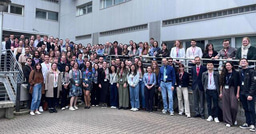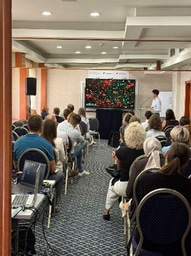What time is it? Glycotime!

There is a quote I once picked up:
“Every biologist is a glycobiologist, they just don’t know about it.”
Every glycobiologist feels like a science evangelist once in a while, on a mission to educate about the wonders of their work. With good reason: perhaps no other field is as understated despite such a heavy clinical impact. For instance, did you know that glycans cover every single cell on earth? They form the outermost part of cell surfaces, usually linked to proteins, lipids, the bacterial cell wall or, as uncovered recently, RNA. Hence, interaction with growth factors, pathogens or antibodies must always take into account how the thick glycan shield can be overcome. Perhaps not surprisingly, all of these agents have found ways to gain access to a cell, often by directly binding to glycans. As early as the 1980s, my mentor and friend Prof. Ten Feizi likened cell surface glycans to “area codes” that can be specifically presented by cells and employed by binding partners. And while we still do not fully understand the details of these processes, “glycotime” is rapidly gaining momentum in therapy and diagnosis. One of the most exciting current developments is the exploitation of so-called glyco-immune checkpoints, pathways in which glycan structures are upregulated by cancer cells to modulate the immune system in a manner that is favourable to tumour growth. Interfering with the function of glyco-immune checkpoints is the focus of promising experimental cancer therapeutics that have now reached the clinic. Likewise, some of the most successful antibacterial vaccines contain glycans as the active ingredient – mounting an immune response against certain bacterial cell surface glycans is a really powerful way to prevent infection.
With such a clinical weight, why does undergraduate education still treat glycans as a by-product of cell biology? Why is biomedicine still largely turning a blind eye to glycobiology? In my opinion – because they are difficult to deal with. While genomics gives us the ever-increasing capacity to understand nucleic acids and proteins in breath-taking detail, glycans are not directly encoded in the genome and are instead made enzymatically. Without elaborate instrumental effort, we cannot know which of the – often branched – glycan structures are found on a particular amino acid. Delving into glycobiology can feel like a rabbit hole, introducing huge complexity into the biomolecule of interest. But fear not, because the glyco-community has your back! It is a glycobiologist’s job to make sure that we don’t mistake complexity for irrelevance. The last decades have seen tremendous advances in the field, comprehensively depicted in 60+ chapters in the free resource Essentials of Glycobiology edited and written by absolute glyco-pioneers. And while we sometimes still struggle with tasks that are trivial for protein biochemists, such as changing the primary sequence of a biomolecule, the community has found creative ways to study glycans in the age of modern biology.
From novel to Nobel
The more challenging a field is, the more it sparks innovation. I am viewing this through the lens of a chemical biologist to whom arguably the most important milestone was the development of “bioorthogonal chemistry”. Therein, chemical tags are introduced into biomolecules in order to react them with reporter moieties in the context of a biological medium. It is no accident that this Nobel Prize-winning strategy (to Carolyn Bertozzi, Barry Sharpless and Morten Meldal in 2022) was developed first to study glycans – there just were not enough ways to do that otherwise, so chemists stepped up. Sugars modified with chemical tags such as azides were fed to cells, incorporated into cell surface glycans and probed with “clickable” fluorophores. Fast-forward 25 years, we now have a host of bioorthogonal reactions at our disposal, with carefully controlled kinetic properties and often minimum background reactivity.
To enter the quantitative biology lab, the field has recognised that we need biological specificity: if glycan biosynthesis is mediated by glycosyltransferase enzymes, can we make bioorthogonal tools that are specific for these enzymes? Can we make tools that serve as reporters for only one specific type of glycans, or for glycans from one particular cell line in vivo? Making such “chemical precision tools” for the community is the focus of my lab. One strategy we employ is termed “bump-and-hole engineering” in which a glycosyltransferase is engineered to accommodate a chemically modified sugar substrate containing a relatively bulky bioorthogonal tag (1). If the modified sugar is not recognised by the wildtype enzyme, we gain a reporter group for the activity of a single enzyme, ideally within the complexity of a cell (2). Using this strategy, we are trying to understand the substrate specificities of glycosyltransferase enzymes, which should give us a clue on their disease relevance. For instance, we recently gained important insight into the biology of (heavily glycosylated) SARS-CoV-2 spike protein, employing chemical tools at every single step along the way (3). Using bioorthogonal chemistry, we tracked sites of glycosylation and found that amino acid substitutions in variants of concern (Alpha, Delta, Omicron) appear to selectively suppress the presence of a particular type of sugars called O-linked sialoglycans. As sialoglycans normally likely impede the maturation of spike, we believe that we helped uncover a role for glycans in the evolutionary trajectory of these variants.
The sweet joy of collaboration
What makes working with chemical tools so much fun is the collaborative aspect of pushing boundaries. I had just completed my undergraduate degree in Biochemistry in Tübingen when I started my PhD with Prof. Peter H. Seeberger in Berlin/Potsdam, fully intending to learn organic synthesis in the context of generating glycan-based antibacterial vaccines (5). While the trajectory from biochemistry to chemistry is rather unusual, getting the opportunity to transition between disciplines proved to be pivotal – brilliant colleagues coached me in organic synthesis, and once I had made my compounds, I could explore their biochemical evaluation, working in the lab of a clinical collaborator. I learned that science knows no boundaries if we are given the freedom to learn and invest the effort to make it count. Doing a postdoc at Stanford with Prof. Carolyn R. Bertozzi gave me access not only to another fantastic and visionary lab environment, but also the world’s experts in new methods in biology. I learned how easy it can be to forge collaborations, for instance by using the then newly-established method of genome-wide CRISPR-KO screens employing our new precision tools (4). The mindset of taking opportunities when they present themselves was very much ingrained in me.
All of these experiences showed me that progress is only worthwhile when achieved as a team. The glycosyltransferase bump-and-hole tactic has its origin in the Bertozzi lab (5). In 2021, when the tactic was setup, a Horizon Prize by the Royal Society of Chemistry was awarded to the entire team that made it happen, which at that time already consisted of about 50 scientists in 5 different countries! Now, as an interdisciplinary group, my lab works closely with biologists in cancer, structure, evolution/development and reproductive biology, identifying their needs to make new precision tools. We collaborate with friends and colleagues in chemistry, appending the newest functional tags to our tools and relying on their expertise in advanced mass spectrometry. We also benefit from a large international and supportive network of glycoscientists.
In a time that sees the value of international funding opportunities vastly underestimated, I would be remiss not to mention how important these are. It is no secret that investing in basic research gives an excellent return. But in the context of international funding schemes such as those by the European Research Council, the benefits even exceed the sheer monetary value, forging networks with experts that we all ultimately benefit from. One can only hope that the nature of collaboration finds strong reception in the years to come. Glycans may be tough to deal with, but the joy of working with them is best conveyed when shared.
I would like to thank all my mentors, colleagues and collaborators, my amazing lab, and our funding agencies.
References:
- Cioce, Malaker, Schumann. Generating orthogonal glycosyltransferase and nucleotide sugar pairs as next-generation glycobiology tools. Opin. Chem. Biol. 2021, 60.
- Schumann et al., Bump-and-Hole Engineering Identifies Specific Substrates of Glycosyltransferases in Living Cells. Cell 2020, 78.
- Gonzalez-Rodriguez et al., O-Linked Sialoglycans Modulate the Proteolysis of SARS-CoV-2 Spike and Likely Contribute to the Mutational Trajectory in Variants of Concern. ACS Cent. Sci. 2023, 9.
- Debets et al., Metabolic precision labeling enables selective probing of O-linked N-acetylgalactosamine glycosylation. Natl Acad. Sci. USA 2020, 117.
- Schumann et al., A semisynthetic Streptococcus pneumoniae serotype 8 glycoconjugate vaccine. Sci. Transl. Med. 2017, 9.
- Choi et al., Engineering Orthogonal Polypeptide GalNAc-Transferase and UDP-Sugar Pairs. Am. Chem. Soc. 2019, 141.
Top image by the Francis Crick Institute





Join the FEBS Network today
Joining the FEBS Network’s molecular life sciences community enables you to access special content on the site, present your profile, 'follow' contributors, 'comment' on and 'like' content, post your own content, and set up a tailored email digest for updates.